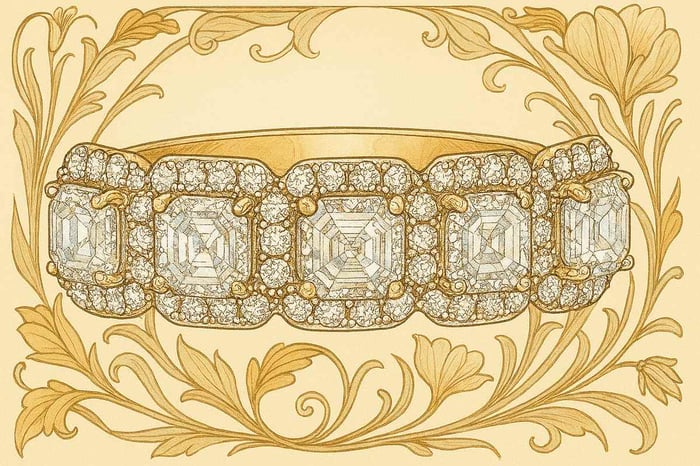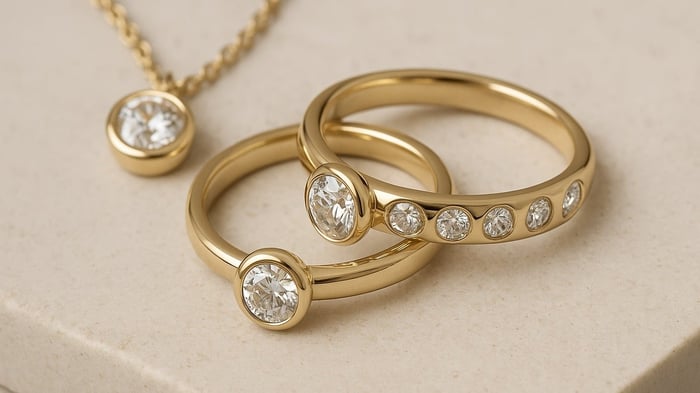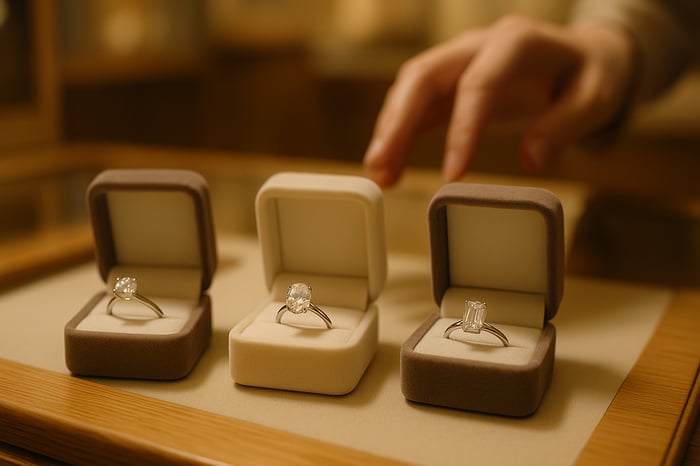Table of Contents
If you’ve ever gazed at an old film and felt mesmerised by the ring glittering on a leading lady’s hand, you might have been admiring an Asscher-cut diamond. This post dips into a cross-century adventure: from Amsterdam workshops steeped in history, through star-studded Hollywood moments, to modern ateliers reimagining classic cuts. Asscher-cut diamonds are more than just a shape; they are a time capsule, capturing innovation, legends, and the sometimes murky sparkle of jewellery marketing. Settle in and discover the inner workings of these entrancing diamonds.
TL;DR: Asscher-cut diamonds blend Art Deco geometry, historical gravitas, and modern technical precision for unmatched sophistication. From Elizabeth Taylor’s legendary ring to the step-cut windmill effect, their story is as much about legacy as it is about light.
Origins and Reinvention: A Square With a Past
The Birth of a Diamond Icon
The history of Asscher-cut diamonds is a tale of innovation, artistry, and enduring family legacy. It all began in 1902 in Amsterdam, when Joseph Asscher of the Royal Asscher Diamond Company introduced a revolutionary cut: a clipped-corner square with step-cut facets that created an “endless pool of mirrors”. This design featured 58 facets, a small table, and a steep pavilion, setting it apart from traditional round and cushion shapes.
Art Deco Fame and Cultural Appeal
By the 1920s and 1930s, the Asscher cut became emblematic of the Art Deco movement, praised for its symmetry and clean geometry. It emerged as a designer favourite for engagement rings and statement jewellery, appealing to those seeking elegance beyond round or princess cuts.
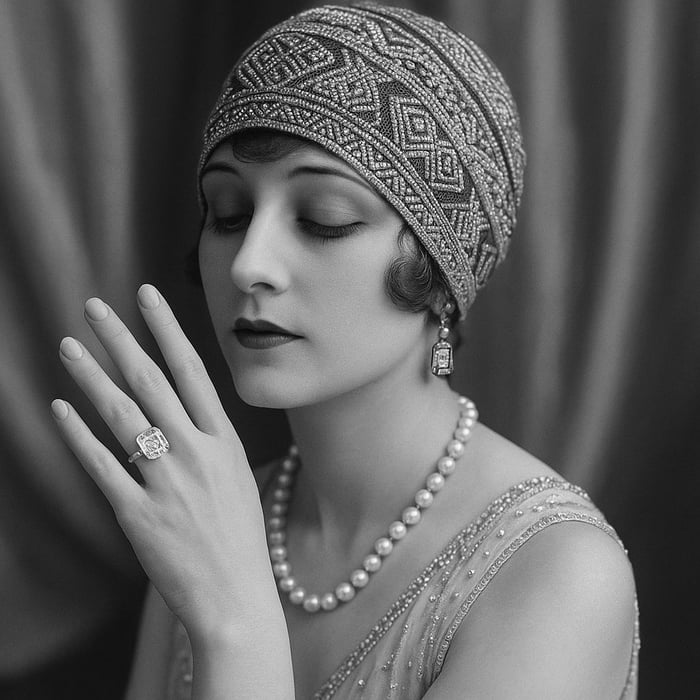
Patent Expiry and Market Dilution
The original patent expired during WWII, and during the Nazi occupation, the Asscher factory was looted, destroying many family records and cutting tools. With the patent gone, other diamantaires began producing similar square step-cuts, often marketed as Asscher or square emerald cuts, though few matched the original’s precise proportions.
Celebrity Revival: Elizabeth Taylor’s Diamond
Despite challenges, the Asscher-cut experienced a renaissance late in the 20th century, fuelled by celebrity interest. Notably, Elizabeth Taylor’s 33-carat Asscher ring—a ring that later sold for $8.8 million—helped reignite public fascination with this elegant cut.
Modern Reinvention: The Royal Asscher Cut
Today, under sixth-generation leadership (Mike and Lita Asscher), the Royal Asscher Diamond Company has refined the original design into the patented Royal Asscher Cut, featuring 74 facets—16 more than the original. This upgrade enhances brilliance and restores the iconic "infinite mirrors" effect for modern luxury.
The Asscher-cut is like looking into an endless pool of mirrors.” —Mike Asscher
This commitment to craftsmanship and clarity ensures that each Royal Asscher Cut diamond honours its multi-generational legacy.
Asscher Cut Diamond Side Stone Engagement Ring 0.55ct G/SI in 18k Yellow Gold

£1,057.00
£1,767.00
This 18k yellow gold engagement ring is an embodiment of grace, featuring a resplendent Asscher cut diamond. The ring is paired with side diamonds, with the same G colour and SI clarity grade, and weighs in at a total of… read more
Summary
1902 – Original Asscher-cut invented and patented (58 facets)
1920s–30s – Art Deco popularity
WWII – Patent expires; copies proliferate
Late 20th century – Celebrity resurgence via iconic pieces
2001 on – Royal Asscher Cut patent, 74-facet modern revival
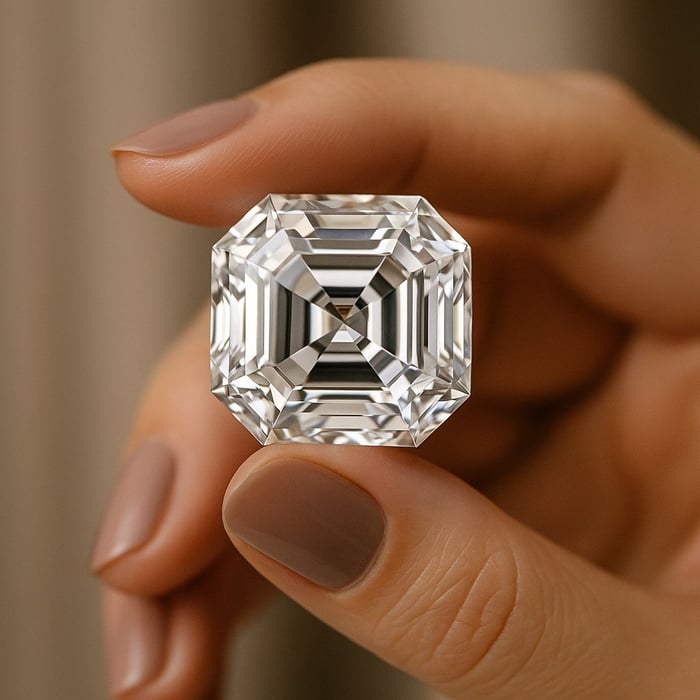
Why the Asscher-Cut Breaks the Mould (and Sometimes, the Rules)
The Asscher-cut diamond stands as a testament to both innovation and tradition in the world of fine jewellery. While many diamond shapes have come and gone, the Asscher cut continues to intrigue collectors and connoisseurs alike, mainly due to its unique blend of architectural geometry and dramatic light play. However, research reveals that not all Asscher-cut diamonds are equal—authentic originals are now rare vintage finds, and modern interpretations often deviate from the original standards.
Not All Asscher Cuts Are Created Equal
The original Asscher cut, patented in 1902 by Joseph Asscher, was the first unique diamond cut to receive a patent. This design featured 58 step-cut facets, a small table, a high crown, and a deep pavilion, all arranged in a perfectly square shape with clipped corners. These features set the benchmark for what would become known as the Asscher-cut diamond features. However, after the patent expired during the Second World War, the term “Asscher cut” became a catch-all for any square step-cut diamond, regardless of how closely it adhered to the original specifications. Today, most new step-cut squares marketed as Asscher cuts do not truly match the original’s proportions or faceting, making authentic vintage pieces highly sought after.
The Windmill Effect: A Visual Hallmark
What truly sets the Asscher cut apart is the so-called windmill effect. This effect is created by the precise alignment of its step-cut facets, which radiate from the centre and resemble the blades of a windmill when viewed from above. Unlike the emerald cut or the princess cut, the Asscher’s clipped corners and symmetrical square shape enhance this optical illusion, giving the diamond a mesmerising, almost hypnotic appearance. As Lita Asscher aptly puts it:
“A true Asscher cut is where geometry and light perform a dance.”This interplay of geometry and light is not just visually striking—it is also a key reason why the Asscher cut remains a favourite among those who appreciate both classic and contemporary jewellery design.
Exacting Roughs for Symmetry and Brilliance
Crafting an Asscher cut diamond requires a rough stone of exceptional quality and shape. Only a perfectly square diamond rough will do, as the cut’s symmetry and brilliance depend on it. This is a significant challenge for cutters, as most rough diamonds are not naturally square. The need for such precision means that diamond cut quality is paramount, and any deviation can compromise the stone’s overall effect.
The ideal length-to-width ratio for a true Asscher cut is between 1.00 and 1.05, ensuring that the diamond maintains its distinctive square shape. This ratio is crucial for achieving the mirrored “endless pool” effect characteristic of the Asscher cut.
Asscher Cut Diamond Side Stone Engagement Ring 0.55ct G/SI in 18k White Gold

£1,057.00
£1,767.00
This 18k white gold engagement ring seamlessly blends elegance with the geometric allure of an Asscher cut diamond. Side diamonds, resonating with a G colour and SI clarity, contribute to its collective weight of 0.55ct. Every ring symbolises our dedication… read more
Clarity and Colour: A Double-Edged Sword
One of the defining features of the Asscher cut diamond is its deep pavilion and small table. While these elements contribute to the cut’s unique brilliance, they also make any imperfections—such as inclusions or colour tints—much more visible. The step-cut facets act almost like windows, revealing the stone’s interior with remarkable clarity. According to studies, this means that only diamonds with high clarity (VS2 or better) and a strong diamond clarity grade are suitable for the Asscher cut. The Asscher cut rewards the finest materials, but it is unforgiving of flaws.
Modern Innovations: Royal Asscher’s Kaleidoscopic Brilliance
The Asscher cut has not remained static. In recent years, the Royal Asscher Diamond Company has introduced a revised version, increasing the number of facets from 58 to 74. This modern interpretation enhances the diamond's ability to reflect light, creating even more dramatic bursts of colour and a kaleidoscopic effect that rivals the brilliance of a round cut. The new design pays homage to the Cullinan II diamond in the Imperial State Crown, further cementing the Asscher’s place in history and innovation.
From the legendary 33-carat Asscher cut worn by Elizabeth Taylor—graded VS1 clarity, Type IIa—to the latest Royal Asscher creations, the cut’s allure lies in its blend of tradition, precision, and bold visual impact. The Asscher cut’s step-cut facets, windmill effect, and square-shaped diamond geometry continue to break the mould, captivating those who seek something truly distinctive in diamond jewellery.
Culture, Icons, and The Real Value of Transparency
The Elizabeth Taylor Spotlight
The Asscher-cut diamond is more than just a geometric marvel; it is a cultural icon, woven into the fabric of both jewellery history and modern luxury. Nowhere is this more evident than in the story of the Elizabeth Taylor Asscher Cut Diamond, a stone whose journey from private gift to auction sensation captures the enduring allure and intrigue of this square-cut masterpiece. When Taylor’s 33-carat Asscher-cut diamond ring, a gift from Richard Burton, sold for $8.8 million in 2011, it was not only the price that made headlines. It was the legacy: a VS1 clarity, Type IIa diamond, cut before the 1920s, worn by one of Hollywood’s most glamorous figures. This single piece of famous Asscher-cut jewellery has done more to anchor the cut’s reputation and desirability than any marketing campaign could hope to achieve.
Royal Heritage and the Cullinan Legacy
However, the cultural significance of the Asscher cut surpasses its appearance on the red carpet. Its royal connections are equally compelling. The original Asscher family, renowned diamond cutters since 1854, were entrusted with the legendary Cullinan Diamond—still the largest rough diamond ever found. Joseph Asscher himself expertly cut the Cullinan II, which now sits in Britain's Imperial State Crown. Such royal and celebrity associations have ensured the Asscher cut’s profile remains sky-high, a symbol of both tradition and innovation.
Architectural Elegance & Provenance Premium
Collectors and connoisseurs are drawn to the Asscher cut for its unmistakable Art Deco vibe and architectural appeal. The step-cut facets, high crown, and distinctive “windmill” effect create a sense of depth and reflection that is both hypnotic and sophisticated. Vintage Asscher-cut pieces, especially those with traceable provenance, are highly prized. Provenance is not just a matter of history; it is a guarantee of authenticity and value. In a world where so many diamonds look alike, knowing the story behind a stone, who cut it, who wore it, and where it has travelled adds a layer of meaning that transcends carat weight or clarity grade.
Transparency: The New Benchmark in Value
Yet, as research shows, the true value of an Asscher cut diamond today is not found solely in its celebrity or royal connections, nor even in its architectural beauty. For modern buyers, diamond marketing transparency is paramount. The open, step-cut facets of the Asscher make any imperfection or colour more noticeable than in other cuts. This means that clarity and colour grades—ideally VS2 or better for clarity and I grade or better for colour—are not just technical details but essential information for anyone considering a purchase. Honest marketing, clear certification, and full disclosure of a diamond’s characteristics are more important than ever. As Bryna Pomp aptly puts it:
"It’s not just the cut, but the clarity of information that turns a pretty diamond into a smart purchase."
Envisioning a Transparent Future
Imagine, for a moment, if every modern engagement ring advertisement laid out the real specs behind the dazzle: the exact diamond clarity grade, the true colour, the precise cut proportions, and the full story of its origin. Such transparency would not only empower buyers but also elevate the entire industry, shifting the focus from marketing gloss to genuine value. The Asscher cut, with its open design and storied past, is uniquely positioned to lead this movement towards greater honesty and consumer confidence.
Asscher Cut Diamond Side Stone Engagement Ring 1.80ct G/SI in Platinum

£8,317.00
£14,917.00
Crafted with meticulous attention to detail, this platinum engagement ring is a testament to timeless elegance. Its centrepiece, a dazzling Asscher cut diamond, is beautifully flanked by side stones. With a collective diamond weight of 1.80ct, they gleam with a… read more
The Royal Asscher Legacy Continues
Today, the Royal Asscher Diamond Company continues to innovate, holding patents on four new fancy shapes and upholding a tradition that spans more than a century. Their commitment to beauty over yield and standardising quality reflects a broader shift in the diamond world: a renewed emphasis on transparency, provenance, and the enduring appeal of authentic craftsmanship.
Final Reflection: Truth in Every Facet
In the end, the timeless allure of Asscher-cut diamonds is not just about square reflections or mirrored depths. It's about the stories we tell, the icons we celebrate, and the trust we build. As the market evolves, the true value of Asscher-cut diamonds will always be rooted in truth, encompassing both the stone itself and the information it shares with its captivated audience.
Discover the Craft Behind the Cut
At All Diamond, we believe that true elegance lies in authenticity. That’s why every piece in our collection features natural diamonds, handcrafted in the UK, and backed by a lifetime workmanship guarantee. Our fine jewellery honours tradition with contemporary sophistication, whether your inspiration is vintage glamour or modern minimalism.
